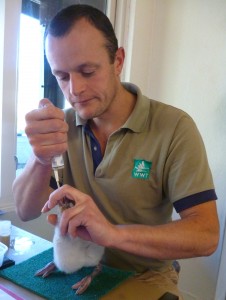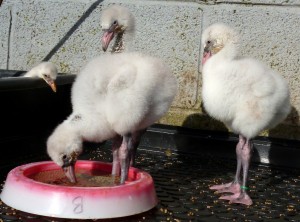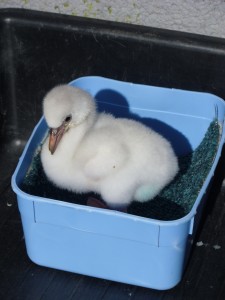Flamingo chicks hand-reared at WWT Washington for very first time
A quintet of fluffy flamingo chicks is being hand-reared at WWT Washington Wetland Centre for the very first time.

Aviculture expert Owen Joiner is providing round-the-clock care for the five Chilean flamingo babies at our specialist breeding facility, as part of long-term plans to boost our existing flock.
The young birds, which hatched during the past few weeks, are from WWT’s headquarters in Slimbridge, Gloucestershire, but were transported to the North East in incubators while still inside their eggs.
They will eventually join WWT Washington’s resident birds next spring, as part of a strategy to increase the flock’s size and enhance its chances of future breeding success.
Aviculture Manager Owen Joiner explained: “In the wild, flamingos nest in large groups, with potentially thousands of birds breeding together. These crowded conditions stimulate natural breeding by giving the birds a sense of stability and confidence.
“Our own flock of 38 Chilean flamingos failed to produce eggs for the fifth season running this year, despite displaying, flirting, mating and nest-building.

“By adding these five new chicks we should stimulate the existing adults into laying eggs, while at the same time increasing the flock size and adding young birds that will hopefully breed themselves in a few years time.”
Because the eggs were laid so late in the season, it was too risky to allow the flamingos to parent-rear the babies due to colder weather and lack of essential sunlight. So the expert skills and knowledge of Owen were called upon instead, for the difficult but rewarding task of raising the chicks by hand.
“Hand rearing flamingos is a delicate matter”, said Owen. “We have dedicated volunteers and staff covering extra duties so that I can commit myself to their round-the-clock care.
“Flamingo parents feed their young with a type of rich saliva, full of all the goodness needed for the chicks to develop. Here, I mimic that by syringe-feeding them every two-three hours with a blended mixture of baby porridge, sardines in oil and egg yolks.

“They also need regular exercise, precise health checks and growth monitoring, to protect their delicate legs as they grow, in case they become too heavy for them.
“At this time of year, lack of sunlight is an issue too, because the chicks need Vitamin D in order to grow and develop properly but can’t be exposed to the cold for too long, so I’ve been supervising ‘sunbathing’ sessions for them when the weather is warm enough.
“Thankfully the hard work and perseverance is paying off and all five are thriving up at our duckery, where visitors can now see them.
“The timing of when we introduce the youngsters to the flock depends on weather, the conditions of the chicks, the behavior of the adults and other factors. Next spring is the most likely time.”
Graham Clarkson, WWT’s Captive Animal Manager, added: “Excellent cooperation between WWT centres and staff has been essential in getting this project underway.
“Chilean flamingos are a near-threatened species and conservation breeding programmes such as this help develop vital staff skills for re-introduction projects for endangered birds.
“The skills and techniques developed by breeding captive flamingos can also pay dividends to wild populations. For example, building artificial nest mounds for wild flamingos has been used with great success at sites in Europe and Africa, where tens of thousands of wild flamingos have hatched directly as a result of this technique pioneered in captivity.”
Video footage to view on YouTube here



